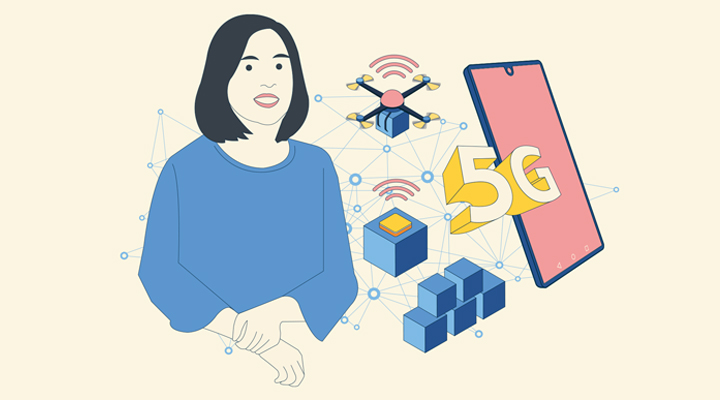Ask A Pro: IMDA Deputy Chief Executive Aileen Chia On 5G For Singapore

Ahead of the curve: Singapore’s approach to 5G
What are the pros and cons of 5G?
5G is the next generation of mobile network connectivity. It will bring us faster speeds and response time, massive connectivity and higher reliability. 5G enables a continuous, near-instantaneous stream of information, allowing for new applications such as safer and more efficient self-driving cars. 5G also supports the communication of millions of Internet of Things (IoT) devices such as smart sensors.
Another powerful new feature is network slicing, which allows for customised networks that support targeted use cases. For instance, auto car-racing teams can have a dedicated virtual network with faster response time capabilities to track their cars’ engine temperature and tyre grips on a more real-time basis. Other virtual networks may have higher speeds for consumers to post multimedia on their social media platforms.
These new possibilities – in healthcare, industrial manufacturing, automation and even entertainment – will boost Singapore’s digital economy and improve our lives. As consumers too, we will gain the benefits of 5G in faster video downloads, cloud gaming and virtual or augmented reality.
With the introduction of any new technology, we have to consider new security and resilience risks. Cybersecurity is vital for a secure and resilient telecommunication network, and for services to support communication needs in an increasingly digitalised economy.
The IMDA will require telecom operators to build 5G networks that are more secure than existing mobile networks. Our requirements include having multiple layers of cyber defence, and more robust authentication of subscribers before granting access. Other regulatory safeguards are regular audits of operators’ networks to address ever-increasing vulnerabilities.

Who is involved in rolling out 5G?
It takes an ecosystem to roll out 5G – from operators, equipment manufacturers and application providers to users and regulators.
Industry players are essential to developing a thriving 5G ecosystem that fuels innovation and creates opportunities. The IMDA is developing open testbeds to enable sharing in the ecosystem and for building of capability. With industry partnerships, global and local companies are starting to using Singapore as a base to trial new 5G use cases.
For example, IMDA is supporting a collaboration between telco M1 and the Nanyang Technological University to use 5G technology in their cellular vehicle-to-everything research testbed.
Important players include:
- Telco operators providing networks and services. All four operators – M1, Singtel, StarHub and TPG Mobile – have been invited to participate in IMDA’s Call For Proposal for two nationwide, standalone 5G networks.
- Equipment vendors providing the smart devices such as smartphones and IOT sensors to consumers and enterprises, as well as the antennas and network equipment for telco operators.
- As the telecom sector regulator, the IMDA ensures that the right regulatory frameworks facilitate the timely deployment of 5G networks while protecting consumer needs, to reach Singapore’s digital economy goals. To accelerate 5G innovation and research, the IMDA supports 5G trials in various public sectors, and co-invests with the industry to develop new 5G use cases for enterprises and consumers.
- For cybersecurity, the IMDA Telecoms Cybersecurity Specialist team works closely with the Cyber Security Agency and industry partners such as telecom operators and equipment providers. The team will set up testbeds for cybersecurity vulnerability assessments, conducting cyber exercises and testing new technologies, with a focus on 5G.
How will 5G developments affect public officers?
We expect 5G to start being deployed by 2020, with 5G capability covering at least half of Singapore by end 2022. The IMDA is working with public agencies to run pilot projects along the way.
Firstly, with the National Research Foundation, we have set aside $40 million to build a 5G innovation ecosystem, and to catalyse 5G research and development.
The IMDA is exploring trials in maritime operations, urban mobility, smart estates, Industry 4.0, and consumer and government applications. This means many of us can expect to experience 5G in our work projects.
Already, we are working with the Maritime and Port Authority and PSA to explore the deployment of 5G technologies in the maritime sector, such as drones, autonomous vessels and remote tele-operations of port equipment.
If you have interesting ideas on how 5G can be tapped, please reach out to IMDA – we will be glad to chat.
Related stories:
Want more? Join us on  Telegram to get alerts when new stories are published on Challenge.
Telegram to get alerts when new stories are published on Challenge.
- POSTED ON
Dec 12, 2019
- ILLUSTRATION BY
Mushroomhead
-
Out of Office

Tantalising Tastebuds, Transforming Lives








